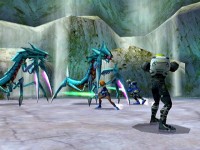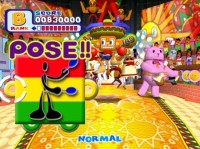If you’ve been a reader of Games Asylum since the beginning, then you have our sympathy. Those that have been with us the whole time though will know that Games Asylum’s roots go back to a Dreamcast site named DigiApe.
Glamorous it wasn’t, being a mixture of HTML coding errors and sloppy grammar and spelling but what it lacked in looks it made up for in enthusiasm – we honestly thought Sega was onto a winner with the Dreamcast.
It’s with DigiApe that myself, Adam and Jake cut our journalistic teeth, with my first ever review being Mattel’s Championship Surfer. Yeah, that old classic. Jake meanwhile made his debut as a news hound by reporting on Virtua Striker 3. He said that the players had nice looking shins. Adam? We forgot but it was probably something about monkeys.
We were keen to report all news Dreamcast related, right down to writing up the review scores from the likes of DC-UK and the Official Dreamcast Magazine. When Sega ditched the Dreamcast the site became a depressing sight – every other news story was confirmation of an anticipated release being canned – and when new releases became thin on the ground, the multi-format site you see here sprang up in its place.
It goes without saying that the Dreamcast has a special place in our collective hearts, and with today marking 12 years since the system launched in Europe there is no better time to share our memories of Sega’s dream machine. Except maybe for its 10th birthday, but we missed that.
Matt
Sonic Adventure
Being the Sega fan boy I was even the screenshots of Godzilla – the first Dreamcast game to be announced – was enough to make me want Sega’s latest. It was Sonic Adventure though that made most put down their deposits.
I can recall downloading the trailer on the college’s then speedy ADSL connection and then after an hour or so of waiting, watching it again and again. Come the Dreamcast’s release it was this and Power Stone I picked up from a midnight launch at Electronics Boutique. The infamous whale chase scene from the first level sticks in my mind the most; and it was that scene that was enough to persuade a friend to buy a Dreamcast the day after launch.
The adventure sections weren’t very well thought out at all, being downright confusing in places, but the chance to run around loops and sprint round corkscrews at high speed made up for the messes that they were.
Power Stone
As Teletext’s Digister said all those years ago, this is “the closest you’ll get to ever being in a bar fightâ€.
Battles were pleasingly chaotic, and each of the environments had their own secret bits to find, such as being able to swing around the lampposts and kick your rival in the face on the 18th century London stage. Pots, tables and chairs could be thrown and weapons were fun to use too. Once three gems were collected you could change into a character that looked like they’d walked off the set of Power Rangers. This is a good thing.
Amusingly, one of the characters had a name change for the western release – Fokker became Falcon, for the obvious reason.
I usually roll my eyes when Capcom announces that they’re re-releasing one of their older games on PSN or XBLA, but this is one I’d be genuinely thrilled to see appear as a download.
Shenmue
It’s easy to forget how long Europe had to wait for Shenmue. Eleven months after it was released in Japan, to be precise. All the while the magazines of the era drip fed us information and the latest screenshots of the English translation, teasing us with tidbits.
Worth the wait? Absolutely. The task at hand was clear – to find who came to Ryo’s house that rainy day and killed his father – but distractions lay around every corner. Playing some of Sega’s classic arcade games, collecting gashpon toys, having a game darts and testing your might at arm wrestling. And of course, looking for sailors. This was part of the plot though. Honest.
We never saw a conclusion to the Shenmue trilogy so I just assume that at the end of Shenmue II the cave’s roof fell in mere seconds after the picture faded out.
Jake
TrickStyle
The Dreamcast was released just as I headed off to university. The game that most captured the collective attention of my flat in halls of residence wasn’t one of the obvious big hitters, but TrickStyle, Acclaim’s middlingly-received hoverboard racer, developed by a pre-Burnout Criterion.
But I bloody loved it – a nice feel to the anti-gravity board, good tracks, and tricks on top of it all.
My flatmates took to it as well, but not in two-player mode. It was for time trials that we’d pile into my room, taking it in turns to attempt to put together that perfect lap.
Favourite Dreamcast game? Yup.
Metropolis Street Racer
MSR was rather better critically received, but as I recall had its fair share of detractors on the online forums of the day. Yes, the Kudos system was flawed and a touch arbitrary, but it was at least consistent – accept that it works how it does, play on that basis, and there’s no problem. As far as I was concerned, anyway.
It’s the locations that really stick in my mind, though. I only appreciated quite how accurately they represented the real-world when I was walking around London from one games show to another, in what must have been 2001, and realised that I only knew where I was going because of MSR. An precursor to Google Street View, if you like.
That also goes to show that I probably played it rather too much.
Crazy Taxi
Did the demise of the Dreamcast bring to an end the era when arcade conversions were kind of a big deal? Probably. Does that also mean that console games today are a bit less fun, in an instant, throwaway sort of way? Possibly.
Crazy Taxi was nothing but fun. Stupid, repetitive, unforgiving, loud, brash fun. It’s one-note gameplay probably has more in common with mobile apps than with modern console games. Times have changed.
Eurogamer‘s recent review of the XBLA and PSN release of the game makes me even more nervous to revisit the game. It was definitely good then, though.
Adam
Jet Set Radio
According to The Wayback Machine, this was the first game I reviewed on this site’s predecessor DigiApe. I liked it a lot back then, and it remains one of my favourite memories of the Dreamcast. I believe I said it was the “best game since Crazy Taxi”, and gave it a lofty 9.5/10, back when I was a foolish 17 year old who thought review scores with decimal places made sense.
Due to its innovative-for-the-time cel shaded graphics, it probably holds up pretty well today. I’ll remember it as one of the most stylish, and really quite fun, games of its time.
Phantasy Star Online
“Is this the best game in existence?” I asked (not too seriously I hope) back in the year 2000. Further research has gone on to show that no, Phantasy Star Online probably isn’t the best game in existence, but it’s still a bit of a landmark title. This was World of Warcraft four years before World of Warcraft (albeit limited to four players and without a massive persistent online world). Or more accurately, it was the first noteworthy online RPG to grace a console.
It was a bit magical, and there hasn’t really been anything like it since, aside from the slightly disappointing Phantasy Star Universe and various PSP titles. PSO remains an iconic name, and fans can still look forward to the much anticipated Phantasy Star Online 2, due for release next year.
Samba de Amigo
Ok, this wouldn’t really make my top three Dreamcast games, but the other two guys above me picked Shenmue and Crazy Taxi. Still, Samba de Amigo is great for three reasons – monkeys, maracas, and Ricky Martin. You can’t really ask for much more than that.
At the time it came packed with a set of maracas, and a slightly extortionate price tag. Clearly it’s a game that has stood the test of time, as Sega re-released it on the Wii a few years ago. If only we knew back then, what we now know about a certain Ricky Martin.










